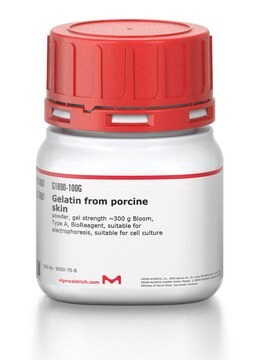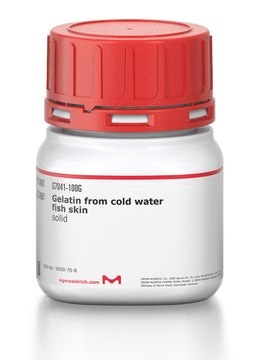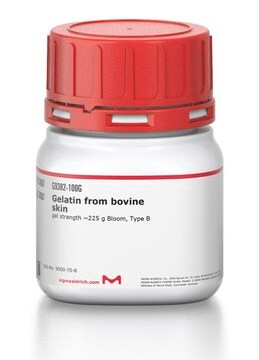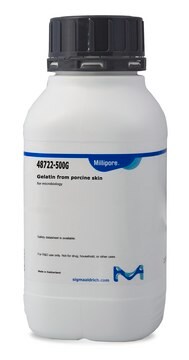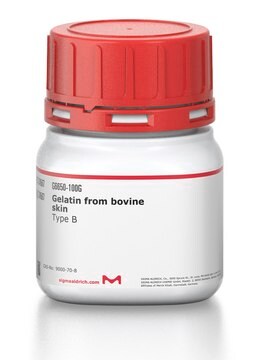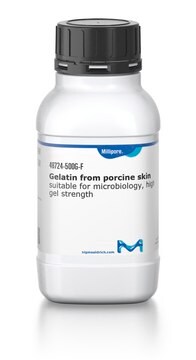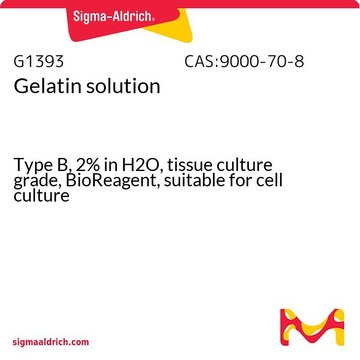G2625
Gelatin from porcine skin
gel strength ~175 g Bloom, Type A
Synonym(s):
Teleostean gelatine
Sign Into View Organizational & Contract Pricing
All Photos(3)
About This Item
Recommended Products
biological source
Porcine skin
Quality Level
type
Type A
form
powder
concentration
65-85% (biuret)
technique(s)
cell culture | mammalian: suitable
solubility
H2O: soluble 50 mg/mL
Looking for similar products? Visit Product Comparison Guide
Application
This product is recommended for use as a cell culture substratum at 1-5 μg/cm2 or 0.5-50 μg/mL. The optimal concentration does depend on cell type as well as the application and research objectives.
Gelatin has been used in many applications. It has use in coating cell culture to improve attachment of cells, being added to PCR to stabilize Taq DNA, as a blocking reagent in Western blotting, ELISA, and immunochemistry, and as a component of media for species differentiation in bacteriology. As a biocompatible polymer, it has used as a delivery vehicle for release of active biomolecules and in generation of scaffolds for tissue engineering applications. In the pharmaceutical industry, geltan can be used as a suspending and encapsulating agent, among other applications.
Gelatin has been used in many applications. It has use in coating cell culture to improve attachment of cells, being added to PCR to stabilize Taq DNA, as a blocking reagent in Western blotting, ELISA, and immunochemistry, and as a component of media for species differentiation in bacteriology. As a biocompatible polymer, it has used as a delivery vehicle for release of active biomolecules and in generation of scaffolds for tissue engineering applications. In the pharmaceutical industry, geltan can be used as a suspending and encapsulating agent, among other applications.
Components
Gelatin is a heterogeneous mixture of water-soluble proteins of high average molecular masses, present in collagen. Proteins are extracted by boiling the relevant skin, tendons, ligaments, bones, etc. in water. Type A gelatin is derived from acid-cured tissue. Type B is derived from lime-cured tissue.
Caution
Dry gelatin, when stored in airtight containers at room temperature, will remain unchanged for many years. When heated at 100°C in the presence of air, it swells becomes soft and disintegrates to a carbonaceous mass with evolution of pyridine bases and ammonia.
Preparation Note
This product is derived from porcine skin. Gelatin is soluble in hot than in cold water. It is practically insoluble in most organic solvents such as alcohol, chloroform, carbon disulfide, carbon tetrachloride, ether, benzene, acetone, and oils. The Bloom number, determined by the Bloom gelometer, is an indication of the strength of a gel formed from a solution of the known concentration. The Bloom number is proportional to the average molecular mass. Bloom numbers of porcine skin Gelatin vary from 90 to 300 g. This product has a gel strength of 175.
Storage Class Code
11 - Combustible Solids
WGK
nwg
Flash Point(F)
Not applicable
Flash Point(C)
Not applicable
Personal Protective Equipment
dust mask type N95 (US), Eyeshields, Gloves
Certificates of Analysis (COA)
Search for Certificates of Analysis (COA) by entering the products Lot/Batch Number. Lot and Batch Numbers can be found on a product’s label following the words ‘Lot’ or ‘Batch’.
Already Own This Product?
Find documentation for the products that you have recently purchased in the Document Library.
Customers Also Viewed
Yu-Dong Ma et al.
Environmental toxicology and pharmacology, 48, 63-75 (2016-10-22)
Migration of vascular smooth muscle cells (VSMCs) contributes to intimal hyperplasia and other vascular diseases. Caveolin-1 (Cav-1) has been recognized as a proliferative inhibitor of VSMCs and is likely to be an important regulator of VSMC migration. The underlying mechanism
J W Bulte et al.
Magnetic resonance in medicine, 25(1), 148-157 (1992-05-01)
Human lymphocytes were labeled with biotinylated anti-lymphocyte-directed monoclonal antibodies, to which streptavidin and subsequently biotinylated dextran-magnetite particles were coupled. This labeling resulted in a strong and selective negative contrast enhancement of lymphocyte suspensions at 2.0 T, caused predominantly by the
Jeffrey W Santoso et al.
APL bioengineering, 5(3), 036101-036101 (2021-07-22)
To develop effective cures for neuromuscular diseases, human-relevant in vitro models of neuromuscular tissues are critically needed to probe disease mechanisms on a cellular and molecular level. However, previous attempts to co-culture motor neurons and skeletal muscle have resulted in
Samuel Burke Nanni et al.
Biomarkers in cancer, 8, 77-87 (2016-05-27)
The low-density lipoprotein receptor-related protein 1 (LRP-1) is a multiligand endocytic receptor, which plays a pivotal role in controlling cytoskeleton dynamics during cancer cell migration. Its rapid endocytosis further allows efficient clearance of extracellular ligands. Concanavalin-A (ConA) is a lectin
Felipe Freitas et al.
eLife, 11 (2022-03-15)
Acute kidney injury is common, with ~13 million cases and 1.7 million deaths/year worldwide. A major cause is renal ischaemia, typically following cardiac surgery, renal transplant or severe haemorrhage. We examined the cause of the sustained reduction in renal blood
Our team of scientists has experience in all areas of research including Life Science, Material Science, Chemical Synthesis, Chromatography, Analytical and many others.
Contact Technical Service
